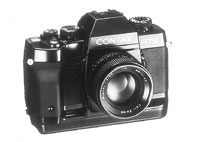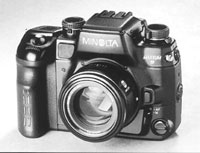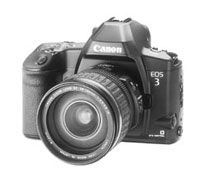There's Something For Everyone
Pro Vs. Amateur 35mm Cameras
Anyone who reads the ads
in photo magazines even occasionally, will be well aware of the 35mm
cameras designated as "professional." Just about every manufacturer
offers at least one and generally prices it far above its "amateur"
counterparts. These models hold a lot of appeal even to photo enthusiasts
on a very tight budget because of a simple theory: that they'll
be able to make better photographs--images that truly achieve professional
caliber--if they acquire a "pro" designated camera. |
|
Superior Quality. Although
there is no industry standard, most camera manufacturers intend their
professional SLRs to function for years, without the need for major repairs.
They employ the finest mechanical and electronic components and assemble
them with extreme precision. Cameras of this type are then pretested for
100,000 or more cycles--and often in extreme temperatures--to ensure long-term
operation without the need for major repairs. Conversely, an entry-level
camera may be expected to function for 50,000 exposures in "normal"
weather, still more than adequate for the vast majority of owners. |
|
The hybrid bodies are every bit as rugged, with a particular advantage: a polycarbonate shell--or thick rubber coating--over a metal chassis is more dent resistant. A part may shatter if dropped onto concrete, but the internal mechanisms will generally continue to operate. More importantly, a polycarbonate shell is unlikely to crack or dent with minor impacts so it withstands common types of pro level abuse that left the 1960's era cameras covered with dents. |
|
Moisture Resistance. An amateur photographer can decide when he or she will shoot, avoiding inclement weather, dust storms, and water spray. When you're on assignment, however, you do not have this luxury. Consequently, most "pro" bodies are well sealed (with gaskets and other precautions) against moisture and dust. No, they're not waterproof but most will withstand a light rain, extreme humidity, snow, or light spray. Saltwater however, still poses a serious risk for any camera, although models with polycarbonate exteriors may be less vulnerable. |
|
An Accurate View. Professional photographers prefer a viewfinder that offers 100 percent area coverage, so they can see exactly what will be recorded on film. The "pro" SLRs meet this demand or come close while more affordable cameras offer 85 to 92 percent area coverage. Some photographers may prefer the latter because a slide mount covers roughly 8 percent of the image area while many labs crop 11 percent of a negative. When shooting with a "pro" camera, you may need to leave extra space around the subject unless you prefer unmounted slides or patronize a lab that will print 100 percent of the negative. |
|
Effective Focusing. Although few professional photographers use autofocus constantly, some do appreciate this capability when recording action or any rapidly changing situation. But they do demand a system that is highly reliable, so "pro" cameras generally include the manufacturer's latest and most successful technology. High-speed continuous "predictive" or "tracking" focus and multi-point focus detection sensors are standard equipment in today's pro-grade AF cameras. Naturally, every model allows the photographer to select a single focus detection sensor, too, for pinpoint control. Photographers who prefer manual focus exclusively are not ignored in this high tech era; several "pro" models are still available featuring an ultra-bright finder and contrasty screen for maximum ease of focusing. |
|
High-Speed Motor Drive.
While a 1 or 2 frame per second (fps) film advance is quite adequate for
photo hobbyists, professional photographers expect higher speed. Whether
the motor drive is built-in or provided with an accessory, a 5 fps advance
rate is generally the minimum expected by those who frequently shoot a
series of frames. High-speed rewind --essential for action and news photography
especially--is a bonus with this type of equipment. Some cameras offer
a much higher rate while others are more conservative; the latter seem
to satisfy many professional photographers. |
|
Other Essentials.
Several other features are just about standard on "pro" cameras,
as our chart indicates. The following are the most noteworthy: |
|
· A PC cord socket that
allows the use of non-dedicated flash units off-camera (or attached to
a studio flash system) in a non-TTL mode. Frankly, many professional photographers
working outside a studio ignore this amenity because of a more recent
alternative: the TTL connecting cable system available for most SLR cameras.
By extending full TTL flash control (and other automation) from the camera's
hot shoe to one or more dedicated flash units, off-camera flash photography
becomes more effective. Nonetheless, some professionals still demand a
PC cord socket so this facility is standard on all "pro" (and
some other high-end) cameras. |
|
Conclusion.
Not specifically labeled as "professional" by Leica, the M6
rangefinder is a strictly manual model that includes very few of the amenities
found on the SLRs in our chart. And yet, it is included because the M6
is used frequently by photojournalists, including some National Geo-graphic
photographers. The reasons are obvious: simplicity of operation; extreme
reliability; compact size; virtually silent operation; minimal delay during
shutter release; no viewfinder blackout; ease of focusing even in low
light; superb build quality; and exceptional optics. NOTE: For a full list of specifications for these "pro" cameras and all other models, review the more comprehensive charts in the 1999 Shutterbug Photography Buyer's Guide. |











































